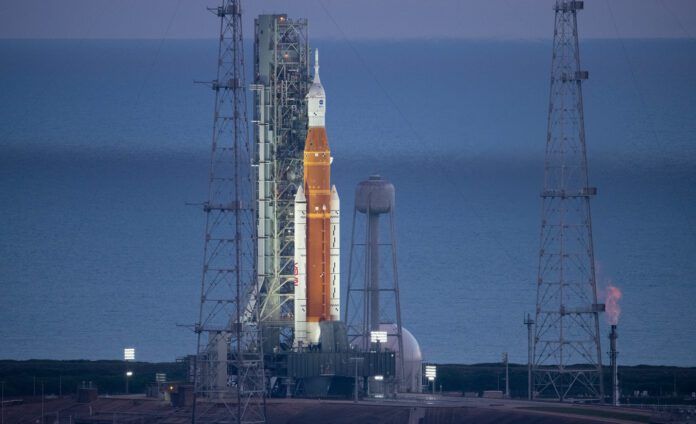NASA’s planned launch of the Artemis I uncrewed flight test of the Space Launch System (SLS) and the Orion spacecraft was called off on Monday. According to the agency, the launch was scrubbed after one of the SLS’s four RS-25 engines failed to reach the correct temperature range for liftoff. While a date has not yet been set for another launch attempt, the next possible window is on Friday, Sept. 2.
“This is part of the space business and its part of particularly a test flight,” said NASA Administrator Bill Nelson. “We are stressing and testing this rocket and the spacecraft in a way that you would never do it with a human crew onboard. That’s the purpose of a test flight.”
NASA noted that several other issues were encountered during the two-day launch countdown, including “storms in the area that delayed the start of propellant loading operations, a leak at the quick disconnect on the 8-inch line used to fill and drain core stage liquid hydrogen, and a hydrogen leak from a valve used to vent the propellant from the core stage intertank.” The agency says it is currently evaluating data gathered during the Monday’s attempt. The mission management team is expected meet on Tuesday to “discuss the data and develop a plan forward.”
Artemis I is the first in a series of missions designed to land people on the lunar surface for the first time since 1972. Artemis II, the program’s first crewed flight test, is scheduled for mid-2024. The anticipated crewed Moon landing, Artemis III, is planned for 2025.




































Been there, done that, (on a tractor). Someone forgot to tighten the radiator hose…
In NASA’s defense, it is probably cheaper to go back and find the lost wrench instead of buying a new one!
Why are we doing this at all? We are nearly $31T in debt as a nation. The day of reckoning for living way beyond our means is already at hand.
Agree. Printing money hand over fist is not “sustainable” since that’s the latest buzz word. On this launch abort, NASA just had a wet test on this system in June and they’re just now finding problems?
The earlier wet test had a small hydrogen leak which could be masked from the launch controller for purposes of completing additional tests, but which did not allow the engine chilling operation – which failed for one engine in today’s effort – to take place.
[The earlier test ended at T-29 seconds instead of at T-10.]
You are correct. This is an old problem to which NASA failed to take corrective action. The engines need to be slowly cooled prior to launch so the sudden onrush of massive amounts of liquid hydrogen don’t damage parts from thermal shock. The bleed system and associated valves failed to deliver enough hydrogen to place the engine’s temperature in a “go” range. In 2021, the launch team pressurized the hydrogen tank to force enough through to continue testing. The working theory was the line was prone to forming hydrogen vapor. Apparently the root cause was not dealth with. All it takes is one guy in charge to theorize without proof to signal an ok to ignore. Thus the engineers who know better get overruled. Very similar to Challenger.
The question of “Why are we spending for space exploration?” has been asked for every major NASA project.
Are the answers any different today than they were for the Apollo program? Or the James Webb telescope? Or for the International Space Station?
As interesting as the JWT pictures are, they look like huge farther away objects magnified to look the same size as the closer objects revealed by the previous generation space telescope. I had hoped to inspect the surfaces of smaller farther objects to see if there are cities and cars.
“Taxes are the money we pay for civilization.”
– Oliver Wendell Holmes
Most concerning to me is the lack of thorough testing, unlike Apollo. The June WDS was terminated early, which left this latest problem to be found on launch day. Even worse, the Orion capsule on this stack does not have the life support and other systems critical for the manned mission, so apparently they will get their first test with live astronauts aboard.
The prudent and safe thing to do would be to wait to test the entire stack in the manned flight configuration, but that would probably mean scrapping these solid boosters (they’re already six months past their designated lifetime, but NASA granted an extension), plus whatever other components might age out. With Boeing moving Starliner’s next launch back to February, ’23, it seems some management issues are coming home to roost. The continued absence of BE-4 engines for ULA’s Vulcan rocket is another black eye.
Of course, an even more prudent and safe option would be to scrap the entire SLS boondoggle and hand the whole Artemis project to SpaceX.
Unfortunately that is not going to happen because there are two many contractors in various Congressional districts to kill the project. After President Obama cancelled the previous NASA rocket design, Congress saw to it that this one, like the infamous Lockheed F-35, cannot be killed. It is frustrating though, since the main booster engines are the same ones used on the Space Shuttle, one would assume that NASA and their engineers would be well familiar with the engine cool-down procedure and have it all worked out.